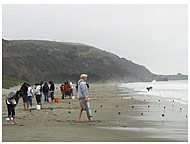Our main objective for monitoring the sandy beach is to establish baseline information about the abundance and distribution of the Pacific mole crab. By monitoring, we can track changes (or lack of changes) in abundance over time. The sampling methods used when our monitoring program was originally established in 2002 are described below. Since then we have been advised to move to a more adaptive method of surveys to better estimate abundance of these mobile creatures. You can find our current protocols here and the baseline report here that recommended we develop new protocols.
Upon arriving at the site, a 50 m rope was laid onto the sand, parallel to the shoreline in dry sand. This rope designated the sampling area, and the rope was marked at each meter. Each group of students was assigned a random number, to locate along the rope, where they would collect samples. Once students located their random number, they would stretch out a 10 m rope perpendicular to the 50 m alongshore survey area rope. This 10 m rope would serve as the group’s vertical transect with the top of the transect always approx. 5 meters above the swash zone. Next, flags were placed into the sand one meter apart along the remaining length of the 10 m rope. Students then collected cores (6 in or 15.2 cm diameter) at each flag, processing each core before collecting the next core, one at a time in sieves as the tide cycle progressed.

Our updated adaptive sampling methods used from August 2019 to the present can be found here

































